Today’s Arctic sea ice claim comes from the Bishop Hill blog of Andrew Montford, which recently stated that:
This morning’s story appears to be the hoary old “Arctic sea ice in freefall” one.
“The Arctic is in crisis. Year by year, it’s slipping into a new state, and it’s hard to see how that won’t have an effect on weather throughout the Northern Hemisphere,” said Ted Scambos, lead scientist at the Colorado-based NSIDC.”
As usual on these occasions, I take a quick look at the Cryosphere Today anomaly page, where I find the sea ice apparently still stuck firmly in “pause” mode.
Having inadvertently wended my way onto The Bishop’s Hill via the northerly extension to Eli’s Rabett Warren I felt compelled, as usual, to quibble with Andrew’s “apparently firmly in ‘pause’ mode” claim. Since graphs in comments are not available over on The Hill, or The Rabett Run for that matter, let’s take a look at some graphic representations of the available data over here instead. Commenter “Golf Charlie” asks at The Bishop’s:
With CO₂ levels continuing to rise, why hasn’t temperature risen, and the ice disappeared as predicted?
Let’s see shall we? CO₂ levels are indeed continuing to rise:
Temperature has risen, as predicted:
Arctic amplification is occuring, as predicted:

Arctic sea ice is disappearing, as predicted:
Q.E.D?
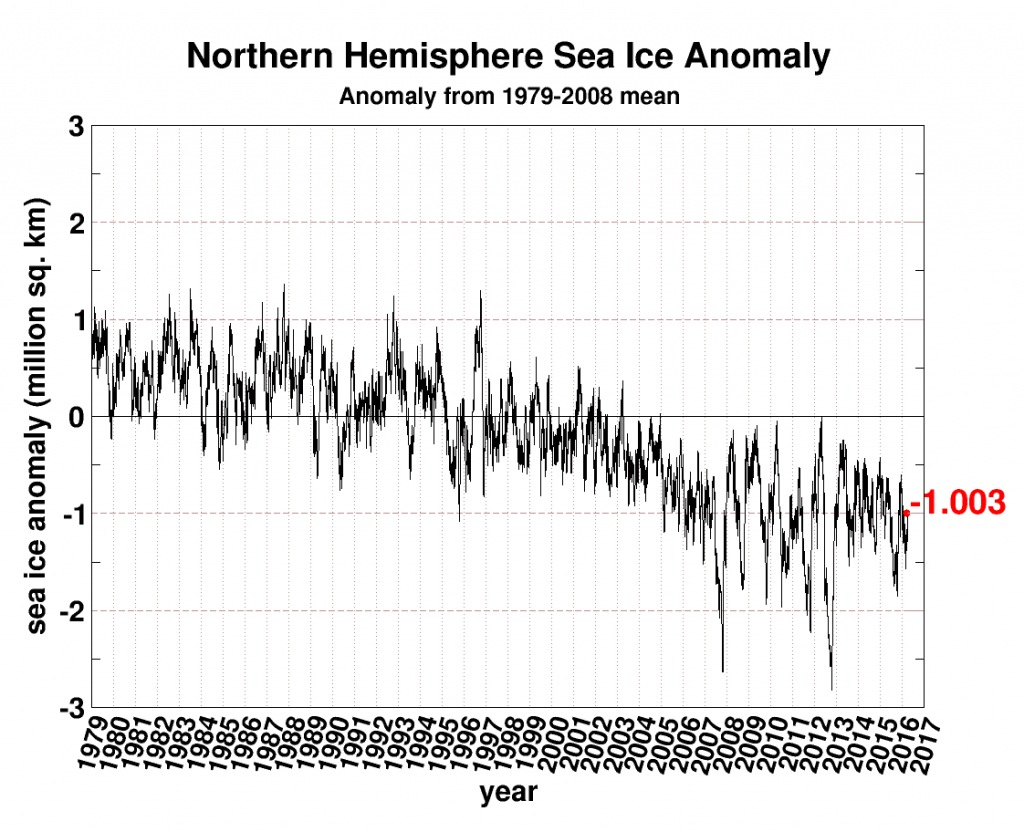
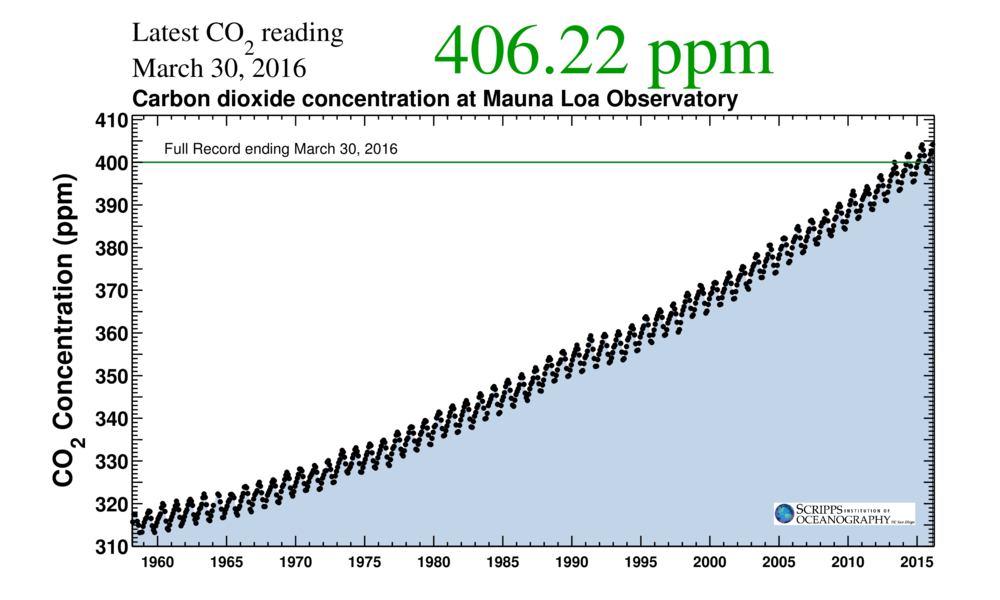
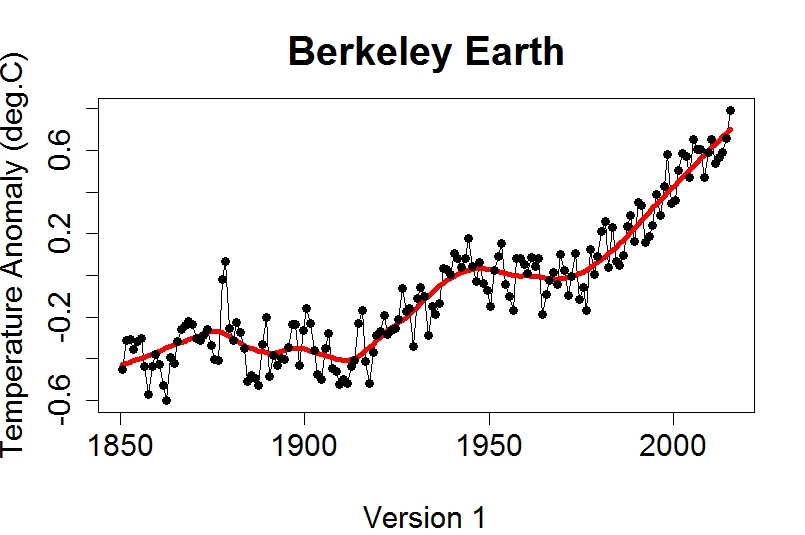
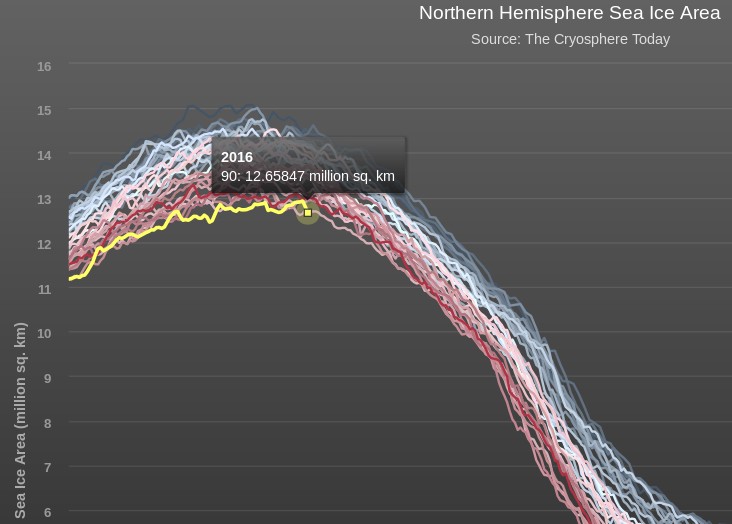
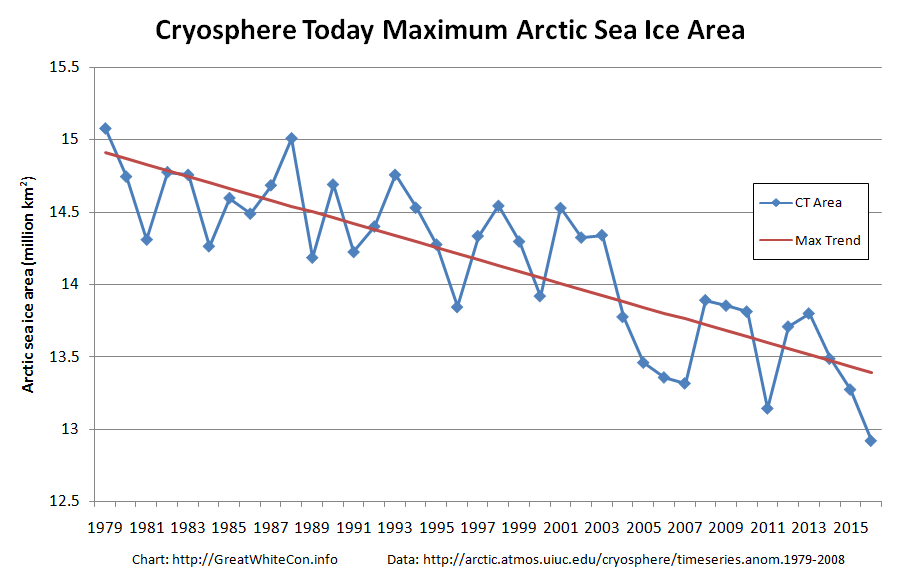
This tool shows sea ice extent evolution for each month:
http://phosphorus.github.io/app.html?id=99853569&full-screen=true
Uses left and right arrows to cycle through the months.
Intriguing though the concept of using Scratch to display Arctic sea ice extent is, I fear I have had to temporarily disable your link. It seems to bring my browser to its knees before showing me this:
What should I expect to see?
The link works fine in opera
It works for me in IE and chrome… Maybe try this viewer instead: https://scratch.mit.edu/projects/embed/99853569/?autostart=true
Maybe it’s something to do with my sluggish broadband connection? I switched from Firefox to Chrome and after taking several minutes to load I eventually saw the animation. Same thing with your second option. The first is now enabled again.
Yes. The sea ice is still holding firm. Okay, it has reduced a bit since measurements began at the end of the, “We are heading into another ice age!” scare; perhaps the ice extent was rather high, then. Certainly, there seems to be no threat of there being no ice at all, as we have been so confidently assured by the more vociferous. Compare the average limit of the ice 1898 – 1913 with the average limit 1981 – 2010 (all right – it is labelled “median”, but it is the best on offer).
Welcome RR,
In actual fact that’s nowhere near the “the best on offer”! Why not compare instead visualisations derived from the machine readable HadISST data set thoughfully provided free of charge to all and sundry by the United Kingdom’s Meteorological Office?
Compare and contrast August 16th 1922:
with August 16th 2015:
Can you spot the difference?
Excellent! Now, as they did not have artificial satellites to help in 1922, where did that information come from? Looking at the map I linked to, above, there is an awful lot of “St of ice unkn”, so it would be interesting to know from where such detailed information was derived, particularly when one acknowledged report from a bona fide expedition investigating the reports of ice loss from that era is so summarily dismissed. I was merely comparing the average limits of ice; the later map does show it to be greater than the earlier.
Which “bona fide expedition” would that be RR, and where and when was it “so summarily dismissed”?
Did you follow in Henry P’s illustrious footsteps by failing to carefully peruse the Met Office’s “manual” for their data set, which does of course provide initial answers to your initial questions?
Oooh, yes – cross-site blunder, there. Sorry. On the Bishop Hill site, from where you raised the headline for argument as to its erroneous implications, I had posted a cutting from “Monthly Weather Review”; The Changing Arctic, by George Nicholas Ifft (November, 1922), a report based on an expedition sent by the Norwegian Department of Commerce to Spitzbergen and Bear Island to: “… survey and chart … take soundings … and make other oceanographic investigations.” I might be terribly mistaken, but would have thought that an expedition that is sent by a state’s governmental department would make the expedition bona fide.
My antagonist in that part of the discussion responded with: “So, in summer 1922 a Norwegian expedition managed to get a little bit north of Svalbard.” You might consider that I am being a little over-sensitive by regarding that as a summary dismissal, which is your prerogative.
The point I was trying to raise was that the Norwegians might be considered one of the most interested parties in the state of sea ice in earlier years, so it is reasonable to assume that they would have pursued its study with a greater intensity than many others. This does NOT exclude any other countries from the debate, but does give greater credence to the Norwegians over others. Seeing how one of these reports is given such a dismissal apparently because it does not fit with the accepted narrative does make one wonder quite what levels of filtering are involved for the UKMO to arrive at their picture.
Perhaps you should follow the Norway Ice Service on Twitter then? Here’s their latest report from Svalbard.
Interesting. However, 1967 is a little over half-way through the acknowledged cooling period from 1945 – 1975. Do they have reliable records from before 1967? Or are the records from before then subject to the new interpretations that are being put on the temperature records?
I’m sorry, Mr Hunt, if you find me too intransigent in this matter, but my nature has always been sceptical. Even when I was one taken in by Al Gore’s film, I wanted confirmation, more details, more information. The more I asked, the more unpleasant became the responses from sites similar to Real Science [sic], quickly descending to advice to self-harm and suicide. I asked the same questions on more sceptical sites; while they offered no more answers to my questions, they were considerably more pleasant about it, readily accepting their ignorance, and their own desire for more information. I have met very, very few who would not accept that temperatures and CO2 levels had risen, or that CO2 can exhibit “greenhouse gas” properties in laboratory conditions; few denied that humans could be having some influence on the CO2 rise or on climates; many are of similar mind to myself. One thing I can be grateful for is that I have discovered Richard Feynman; I suspect that, were he still alive, he would be firmly in the “denier” camp.
As luck would have it I have a copy of Feynman’s Lectures on Physics on my bookshelf, left over from my quantum mechanics lectures as an undergraduate:
Are you familiar with the tale of Richard Mueller, another famously “skeptical” physicist?
How about the story of Stephen Mosher, author of “The Crutape Letters“?
They did their Charles G. Koch funded detailed due diligence and came to this conclusion:
Thank you for the introduction to those others; I have heard the names, but not their contributions.
Odd as it may seem, I have no argument with the rise in temperatures – long may it do so, in my opinion, as, to date, it has brought us so many benefits. Where I draw the line is that it is only down to increasing CO2 concentrations in the atmosphere, and that these are increasing only because of humanity’s consumption of fossil fuels – and the only way to stop the CO2 increase is for only the “Western” nations to stop burning fossil fuels. Oh, and that any further increase is only going to cause death and destruction on unprecedented scales. What makes it rather bizarre is that the “solution” is to cause death and destruction of the “West” on an unprecedented scale: “This is probably the most difficult task we have ever given ourselves, which is to intentionally transform the economic development model, for the first time in human history.” (Christiana Figueres, when leader of the U.N.’s Framework Convention on Climate Change.) I don’t know about you, but that sentiment sends a chill of fear through me, and it is that mentality I will fight to my last breath.
“A lot of people are getting very famous and very well-known, as well as very well-funded, as a result of promoting the disastrous scenario of greenhouse warming.” – Dr Sherwood Itso, US Conservation Labs.
Thanks for your honesty RR, but has the thought ever crossed your mind that the passionate and essentially political (or so it seems to me) position you describe might be clouding your dispassionate scientific scepticism when it comes to examining the available data?
I see your point, Mr Hunt. I feel that it is because I found that we were not being told the full truth, and the only reasons I have been able to determine for this subterfuge are political. I do not like being manipulated in such an underhand manner, and it grates that others are also falling for the same lies – or, at least, expected to believe the lies, else be derided as a “denier!” I have found that every one of the … well, at risk of ruffling feathers, let’s call them “AGWists” … that I challenge to provide evidence about the cause and the projected catastrophes, will very quickly resort into name-calling and ridiculing. If – big IF – they could provide a fact and accept that I would challenge that until satisfied that it was an undeniable fact, I would be more prepared to listen (or, to be pedantic, read). I am sure that a quick perusal of the BH site will give you plenty of examples of what I am talking about – yes, I know that there are a lot of regulars who pounce on people whom they see as interloping AGWists; when I see that, I try to intervene and prevent them falling into the trap that so many AWGists have fallen into, which is derision of the opposition, though there are some whose sole reason for commenting is to invoke that level of response (notice the Eli Rabett did not bother to show any examples of where I had made the “ad noms” [sic] that he accused me of).
In short: yes, the thought has crossed my mind and, in so doing, enables me to properly review my scepticism – so, no, I do not think that my view is too clouded.
The zealots on both sides often resort to such “ad noms”. I have collected some fine examples for posterity:
https://greatWhiteCon.info/?s=einstein
My apologies to all and sundry for “cherry picking” yet another famous physicist. Eli introduced some actual evidence into the debate on the Bishop’s Hill:
As Russell pointed out over there:
Is that an “ad nom” or a humourous response to comments from GC such as “vvussell is one of the sharpest tools in climate science.”?
Please feel free to peruse some of “The satellite photo intel on ice extent” available here:
https://greatWhiteCon.info/resources/about/
Getting back to the psychology and politics of the “CAGW debate”, I have also assembled plenty of evidence that the “skeptical” media “manipulate their audience in an underhand manner”. Would you like to read some of that too?
The sad thing is, there is very little “sceptical” media; most of the mainstream media are full-on AGWists, and push that line as hard as they dare (just try watching the BBC for that – or the ABC or CBC, depending where in the world you are). There are a few who can appear to be sceptical, but still somehow manage to twist it round to the “consensus” view.
Surely you jest RR? For your edification here are a couple of prime UK centric examples:
https://greatWhiteCon.info/tag/daily-mail/
and
https://greatWhiteCon.info/tag/telegraph/
Well, I did say “very little”, not “none at all”. There is a certain irony in the titles you selected as, despite both having considerably greater circulations than the very pro-consensus Guardian (a.k.a. “Grauniad”), they jointly have considerably less “clout” with the glitterati – for example, it is commonly considered that the BBC use the Graun as their primary source of news.
Cherry picking Feynman to hide the reactionary dogma of climate doom seems beneath a good willed discussion. Feynman on balance speaks out strongly against the sort of dogmatic magical thinking so characteristic of the climate consensus.
The bottom line is you can bang the drum of Arctic sea ice, hope no one critically reviews the current claim in an historical context, and you are still left looking for any symptoms of doom beyond the allegation of uniquely low sea ice.
And since every other prophecy of doom has failed to pan out, you are in the similar position of the organ grinder monkey with only one tune to play.
RR introduced Feynman if you recall? I “cherry picked” Mueller! What about the “dogmatic magical thinking” so characteristic of the “climate skeptics”?
Please feel free to “critically review” the current Arctic data “in an historical context”. However please do provide some credible evidence for any assertions you may make.
A lot of sceptics are getting very frustrated by the debate – indeed, I am losing interest in it, myself, and just try to observe (I still need a bit more practice at that) – as the counter-argument to a sceptical, “Show us the evidence that we are heading for catastrophe,” is so often NOT, “Here is it! Ta-daa! Read it and weep,” but more like: “Where is the evidence that there is no evidence?” or, perhaps even worse, “Where is the evidence that we are NOT heading for catastrophe?” As a result, sceptics can be a little abrupt in their challenges – this is not excusing their actions, it is merely explaining why so many are like that. Most sceptics are willing to accept that the world is warming, the ice is melting and the climates are changing; they are reluctant to blithely accept that it is all the fault of humans, and that we need to dismantle our civilisation to “save the world”. With the Arctic, there is some evidence to suggest that the ice loss, such as it is, has little to do with “global warming” and more to do with geothermal activity beneath the ocean, there being a geothermal ridge under the western portion of the Arctic ocean that appears to have become a bit more lively recently, and beneath the ice of Greenland, with most of the ice melting from the bottom, not the top.
In which case I trust that you will completely understand if I ask you to provide some credible evidence, preferably in the form of at least one peer reviewed article in a credible academic journal, of the “recently more lively geothermal ridge under the western portion of the Arctic ocean”?
I am sorry, Mr Hunt, but I do not have your level of scientific training, so let references slip away without making a note of them or where they are. The best I can come up with at the moment are this: http://www.nature.com/ngeo/journal/vaop/ncurrent/full/ngeo2689.html, and this: http://www.climatechangedispatch.com/geothermal-heat-and-the-arctic-ocean-sea-ice.html
The latter is probably not up to the standard you will be demanding (but does show me to be wrong – the ridge/rift is actually to the east of Greenland), but does conclude with a reference to the National Science Foundation. I am sure that you will be more aware of the credibility of that organisation than I, as well as that of the author of the piece.
You are correct about the latter link! What do you make of this argument?
http://forum.arctic-sea-ice.net/index.php/topic,1377.msg69559.html#msg69559
A reasonable argument, though I do not agree with the final sentence: first, the use of the word “forcing”, then the concept of those molecules absorbing the heat, then transmitting it all Earth-wards again (though the first picture that came to mind was of a CO2 molecule wearing dark glasses sidling up to a nitrogen molecule: “Psst. Want some heat?”). Sorry, that may be one theory, but it has yet to be verified; it certainly does not fit in with the steadily rising CO2 and the more sporadic increases (and occasional decrease) in temperature.
“It has yet to be verified”
Surely you must know the drill by now RR? Reputable scientific papers from reputable academic journals please. Not evidence free assertions.
Have you by any chance read our handy “Greenhouse Effect FAQ” yet?
As a student of history I’m sure you must have found this bit to be of interest?
What evidence-free assertion have I made? I merely noted that the “greenhouse effect” theory of CO2, popular as it may be, has yet to be verified. How can I produce evidence of a nothing? My understanding is that it has long been acknowledged that the concentration of CO2 in the Earth’s atmosphere has been rising more-or-less steadily, while the temperatures have been considerably more sporadic. I am sorry if you think that I have to produce evidence of that, because, if you do, then it is highly likely that whatever evidence I do submit will be summarily dismissed as below your personal high standards.
There are other theories as to how atmospheres affect planetary temperatures, at least one of which can be shown to be more realistic than the standard GHE, that is the present favourite, when looking at other planets – for instance, it explains why Venus is a lot cooler than it should be, under the existing GHE theory.
At the risk of repeating myself:
Yes, I have. Do not ignore the fact that if there was no atmosphere, there would be no water, thus there would be no ice.
If that’s the case, did you click the link and read Ray Pierrehumbert’s article in Physics Today?
If so, what did you make of it?
Yes: very interesting theory. A lot more information needs to be gathered, and now that we are developing the technology to gather the data, things will get more interesting.
Surely you are jesting once again RR? It seems that you’ve never met Iris before? Let me introduce you:
http://nssdc.gsfc.nasa.gov/nmc/spacecraftDisplay.do?id=1969-037A
Jesting? What about? That gathering more information through various means is something to look forward to? Of course, there are times when that gives you answers you do not expect; there must be error in the satellite, so let’s remove it.
Kasia has rather hit the nail on the head, don’t you think? You said:
As Pauli put it:
Kasia clicked the helpful link, read the text, then said:
You want to wait until somebody invents the time machine?
My apologies if the surrealism goes over your head, but you started it.
Well, five decades is a good start. As for time travel, it can have its risks,
whichever way it is done.
RR – So are we now finally all agreed that “the concept of those [CO₂] molecules absorbing the heat, then transmitting [some of] it Earth-wards again” has been “verified” by satellite measurements for the last 45 years or so?
Are we further all agreed that “temperatures have been rising more-or-less steadily” for the last 45 years or so?
Hello Repetitive Rodent,
The technology was invented a long, long time ago.
An infrared interferometer spectrometer (IRIS) for measuring the emission spectra of the earth-atmosphere system was launched on 1969-04-14.
Please, go to the website and see it for yourself. And I am sorry that you are missing all the surreal emphases that the beautiful Snow White is trying to teach you.
Snow White, please stop wasting your time here, go and spend more time with your Prince Charming, he is longing for some good sex. Maybe you can start to think about an exciting experience: a scion. Maybe a new Bill the Frog? Kisses
Kasia – Thanks for your suggestion, and as exciting as does indeed sound I’m afraid I’ll be stuck at my keyboard here at Great White Con Ivory Towers typing in the recurring “Shock News!” for the foreseeable future. Currently I’m proof reading a new contribution by Bill The Frog (AKA Prince Charming). Here’s a brief preview:
Jim, how can an anomalies graph be so heavily weighted ?
The release of geothermal heat from the El Hierro submarine volcanic eruption in the north Atlantic Ocean and the Nishino-shima volcanic eruption in the north Pacific Ocean was found to be responsible for decadal Arctic sea ice variability based on an analysis of observation records.
Please see my Spring 2018 article in Imperial Engineer Issue 28 page 26.
A thought springs to mind: https://xkcd.com/552/